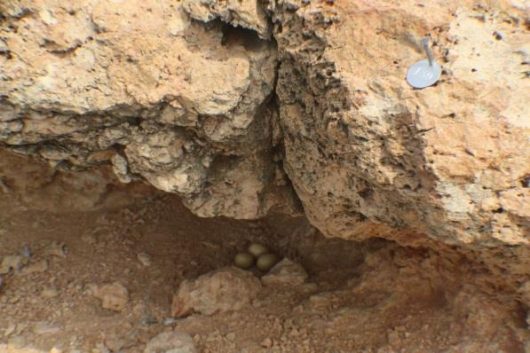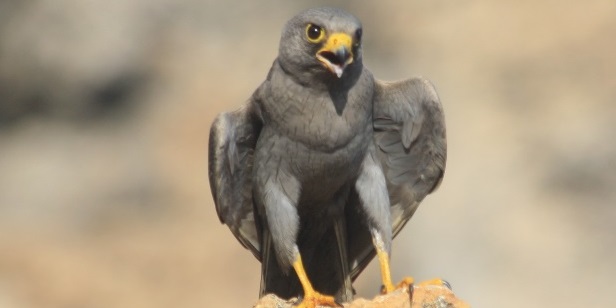Reproduction and population dynamics of a poorly studied, Near Threatened, colony-nesting raptor
LINKED PAPER
Sooty Falcon Falco concolor reproduction and population dynamics on the islands in the Sea of Oman. McGrady, M.J., Al-Fazari, W.A., Al-Jahdhami, M.H., Nicoll, M.A.C. & Oli, M.K. 2017. IBIS. DOI: 10.1111/ibi.12502 VIEW
Sooty falcons Falco concolor are fascinating, Near Threatened falcons that breed in the Middle East and north Africa in high summer. In doing so they can (like Eleonora’s Falcon Falco eleonorae) feed their nestlings on autumn migrating birds moving from Eurasia to Africa. In some places they nest colonially, and Oman is seen as a stronghold for breeding Sooty Falcons. Despite their interesting ecology and poor conservation status very little research has been undertaken (perhaps because temperatures at breeding sites can reach 50oC), and the lack of information undermines efforts to conserve them. Indeed, into the 1990’s the global population may have been overestimated by a factor of 40 (see Kavanaugh & King 2008)!
Video 1 A movie about sooty falcons that includes our field work was made to help raise awareness about sooty falcon conservation amongst a larger audience.
Our study found that Sooty Falcons nesting on islands in the Sea of Oman laid an average of 2.83 eggs/nest, and that 11.7% of nests failed between egg and nestling stages; mean brood size was 2.11. We found that reproduction was better on an island close to the mainland (Fahal Island) than on islands farther offshore, and argue that this is because adults on Fahal could hunt over the capital city of Muscat during the early breeding period before migration of prey birds had commenced. In addition, despite being closer to the capital than other islands, Fahal is difficult to land on and is more effectively patrolled by the police, ensuring that human disturbance there was low compared to the other islands. We used the data and information on survival (McGrady et al. 2016) to calculate an annual asymptotic population growth rate of 0.87, suggesting the population is in decline, mostly driven by apparent low survival.



These results and analyses of other data collected by us in Oman will feed into the Single Species Action Plan being developed for the Sooty Falcon, which is being facilitated by the Convention on Conservation of Migratory Species (CMS) Office in Abu Dhabi, as part of the so called Raptors MOU initiative.

Sooty Falcons are migratory, and, again like Eleonora’s Falcon, most spend the non-breeding season in Madagascar. Even less is known about Sooty Falcon migration and ecology during non-breeding months, though they do seem to feed on more insects outside the breeding season. Importantly, it appears that it is away from the breeding areas that most mortality occurs, and mortality, particularly of adults, is the main driver of the population decline. If most mortality is indeed happening away from the breeding areas then it is critical that more is learned about falcons during those times, if effective conservation plans are to be developed and implemented.
Read Mike’s other blog posts on #theBOUblog:
Peregrine recovery: building on successes
Survival is (not) a dying art
References and further reading
BirdLife International. 2017. Species factsheet: Falco concolor. VIEW
Kavanagh, B. & King, H. 2008. Observations from 1998-2006 on the breeding population of Sooty Falcons Falco concolor on the Hawar Islands, Kingdom of Bahrain. Sandgrouse 30: 70-76. VIEW
McGrady, M.J., AlFazari, W., AlJahdhami, M.H. & Oli, M.K. 2016. Survival of Sooty Falcons (Falco concolor) in Oman. Journal for Ornithology 157: 427-437. VIEW
Schwarze, H. & al Toubi, K. (Producers) and Jähne, R. & Herbort, S. (Directors). 2017. The Migrant – Sooty Falcons in Oman [Motion Picture]. Diwan of Royal Court, Office for Conservation of the Environment, Oman. VIEW
CMS Memorandum of Understanding on the Conservation of Migratory Birds of Prey in Africa and Eurasia (Raptors MOU). VIEW
Image credit
Featured image: Adult Sooty Falcon © Mike McGrady
If you want to write about your research in #theBOUblog, then please see here.





